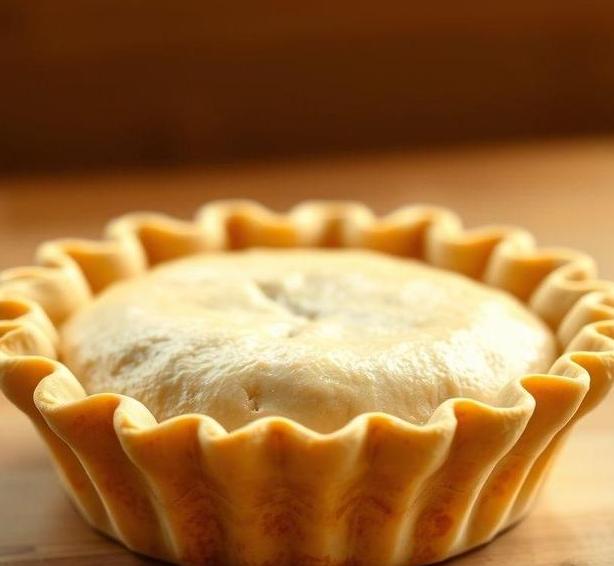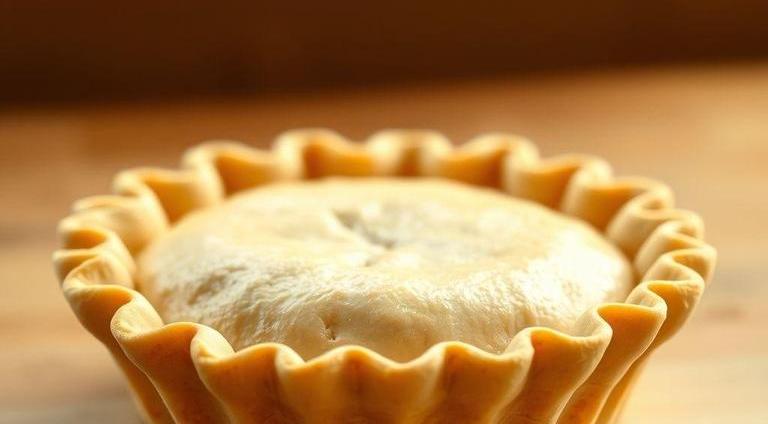Pie crust, that delicate, buttery, flaky layer that cradles the filling of your favorite pie, is an essential part of many dessert recipes. Whether you’re making a classic apple pie, a savory quiche, or a decadent cream pie, the crust often serves as the base that holds it all together. But have you ever wondered how long that pie crust will stay fresh? Or whether it can spoil if you leave it in the fridge or pantry too long?
In this guide, we’ll walk through the ins and outs of pie crust’s shelf life, its potential to go bad, the best storage methods to extend its life, and expert tips on keeping it in prime condition. So, let’s get into it!
Can Pie Crust Go Bad?
Absolutely, pie crust can go bad. Just like any other baked good or ingredient, it has a limited shelf life, and how long it lasts depends on several factors such as the type of crust (homemade vs. store-bought), how it’s stored, and the ingredients used. The problem with pie crust going bad isn’t always about spoilage in the traditional sense like mold; it can also deteriorate in texture, flavor, or become overly dry or crumbly. The fats and oils that keep pie crust soft and flaky can eventually break down, causing the crust to lose its best qualities.
Here’s why:
- Fat and moisture content: The fats in pie crust (usually butter, shortening, or lard) keep it tender. But over time, these fats can oxidize and go rancid, causing the crust to develop an unpleasant taste or odor.
- Flour exposure: Flour can absorb moisture from the air, especially if not sealed properly. This can lead to a stale, dried-out crust, making it less desirable to eat.
Understanding the shelf life and signs of spoilage is key to preventing a ruined dessert!
Shelf Life For Pie Crust

The shelf life of pie crust varies depending on whether it’s homemade or store-bought, and how it’s stored. Let’s break it down:
Homemade Pie Crust
- Unbaked (stored in the fridge): 2-3 days
- Frozen (raw, for future use): 3-4 months (wrap it tightly in plastic wrap and foil for optimal storage)
- Baked (kept in the fridge): 3-4 days (but best enjoyed within the first 2 days for optimal texture)
Store-Bought Pie Crust
- Unopened (in pantry): 1-2 months past the “best by” date
- Opened (in the fridge): 2 weeks (after opening, always reseal the package tightly)
- Frozen (unopened): Can last up to 6 months if stored properly in the freezer, but best used within 3 months for best texture
The key to keeping your pie crust at its best is to store it correctly and use it within the appropriate timeframe.
Common Signs Of Spoilage
How do you know when your pie crust has gone bad? Here are some telltale signs to watch out for:
Smell
- Rancid or sour odor: If your crust smells off, it’s a sign that the fats have gone bad. A rancid smell usually means that the butter or shortening has spoiled. If the crust smells sour or unusual, toss it.
Appearance
- Discoloration: Look for any discoloration on the surface, like dark spots or yellowing. This could indicate the crust has been exposed to air too long and the fats have started breaking down.
- Mold: This is more likely to happen with homemade pie crust or if it’s been improperly stored. Any mold growth should make the crust unsafe to eat, and it’s best to dispose of it.
Texture
- Dry, Crumbly, or Brittle: If you notice that the pie crust has become excessively dry or crumbly when you handle it, it could be a sign that it has lost moisture. While this won’t necessarily make it harmful to eat, the texture will be unpleasant, and it won’t perform well in your pie.
- Dough becomes sticky or tacky: If the dough feels unusually sticky or tacky, it could be due to bacterial growth, especially if the dough has been sitting at room temperature too long. This is a definite sign of spoilage.
Taste
- Off or unpleasant flavor: A spoiled pie crust may have an odd taste, especially if it’s rancid. The fats breaking down can leave behind an unpleasant, bitter flavor that will affect the overall taste of your pie.
How To Store Pie Crust?

Proper storage is the secret to extending the shelf life of your pie crust, whether it’s raw or baked. Let’s talk about the best ways to store both homemade and store-bought pie crust:
Storing Homemade Pie Crust
-
Refrigeration (Short-Term Storage)
- Wrap the pie dough tightly in plastic wrap, then place it in an airtight container or a resealable plastic bag. This prevents air from getting in and keeps the dough from drying out.
- Store the dough in the fridge for up to 2-3 days. You can also store the crust in the fridge after it’s been rolled out and shaped, just be sure to cover it well to prevent it from drying out.
-
Freezing (Long-Term Storage)
- For longer storage, freeze the dough. First, wrap it tightly in plastic wrap, then cover it in aluminum foil or place it in a freezer-safe bag. It should last for 3-4 months in the freezer.
- When you’re ready to use it, allow the dough to thaw in the fridge overnight before rolling it out.
Storing Store-Bought Pie Crust
-
Unopened Package
- Store the unopened package in a cool, dry place like a pantry. Be sure to check the “best by” date on the packaging to determine the optimal timeframe.
-
Opened Package
- Once opened, you should store any leftover crust in the fridge. Wrap it tightly in plastic wrap and place it in an airtight container to preserve its freshness.
-
Freezing
- If you don’t plan on using the crust within a couple of weeks, freezing it is a good option. Just make sure the original packaging is sealed tightly or transfer it to a freezer-safe bag.
Expert Tips
Want to take your pie crust storage game to the next level? Here are some expert tips to keep your pie crust fresh for as long as possible:
- Use parchment paper: If you’re storing a rolled-out pie crust, place it on a piece of parchment paper before wrapping it. This will prevent the dough from sticking to the plastic wrap and help preserve its shape.
- Chill dough before rolling: After mixing your dough, it’s a good idea to chill it for at least 30 minutes before rolling it out. This will help the fat solidify and keep the crust flaky.
- Seal tightly: Air exposure is the biggest enemy of pie crust. Whether you’re refrigerating or freezing, always wrap it as tightly as possible to prevent moisture loss and oxidation.
- Freeze individual portions: If you often use pie crust in small amounts, consider portioning your dough into smaller disks before freezing. This way, you can easily thaw just what you need without defrosting the whole batch.
FAQs
Can Pie Crust Go Bad If Left Out At Room Temperature?
Yes, pie crust can go bad if left out at room temperature for too long. Unbaked pie crust can spoil after a few hours due to the perishable nature of its ingredients, particularly butter or lard. If it’s baked, it can still become stale or lose flavor if exposed to air for extended periods.
How Long Can I Store Pie Crust In The Fridge Before It Goes Bad?
Pie crust can be stored in the fridge for up to 3 days. After that, it may start to lose its freshness, with the dough becoming dry or developing an off smell. It’s always best to wrap the pie crust tightly to avoid exposure to air and moisture.
Can Pie Crust Dough Be Frozen?
Yes, pie crust dough can be frozen. It should be tightly wrapped in plastic wrap or placed in an airtight container to prevent freezer burn. When properly stored, frozen pie crust can last for up to 3 months. Just thaw it in the fridge overnight before use.
What Signs Indicate That Pie Crust Has Gone Bad?
Signs that pie crust has gone bad include a sour or rancid smell, discoloration (such as yellowing or browning), or a dry, crumbly texture. In addition, if the dough is slimy or sticky when you touch it, it has likely gone bad.
Does Pie Crust Have An Expiration Date?
Yes, pre-made pie crusts do have expiration dates, which are typically printed on the packaging. These dates are a guideline for freshness and safety. If you have homemade pie crust, it doesn’t have an expiration date, but it can spoil over time depending on storage conditions.
Can I Use Pie Crust After Its Expiration Date?
Using pie crust after its expiration date is not recommended. The crust may not have the same texture or flavor, and in some cases, it could be unsafe due to spoilage. Always check for signs of spoilage such as off smells, discoloration, or texture changes.
Can Frozen Pie Crust Go Bad?
Frozen pie crust can go bad if it is not properly stored. Over time, it may suffer from freezer burn, which affects its taste and texture. For the best quality, consume frozen pie crust within 3 months.
How Should I Store A Homemade Pie Crust To Prevent It From Going Bad?
To store homemade pie crust, wrap it tightly in plastic wrap or place it in an airtight container. If you plan to keep it for more than a few days, freezing is the best option. Always refrigerate the dough if storing for up to 3 days or freeze it for longer storage.
Can I Still Bake With Pie Crust That Has Gone Bad?
It is not recommended to bake with pie crust that has gone bad, as the flavor and texture will be compromised. If the pie crust smells rancid, has an unusual color, or feels slimy, it should be discarded.
What Happens If Pie Crust Dough Is Left Out Overnight?
If pie crust dough is left out overnight, especially in warm environments, it can spoil. The fats in the dough, like butter or lard, can break down, and bacteria may grow, making it unsafe to use. It’s always best to refrigerate pie crust dough or freeze it for longer storage.